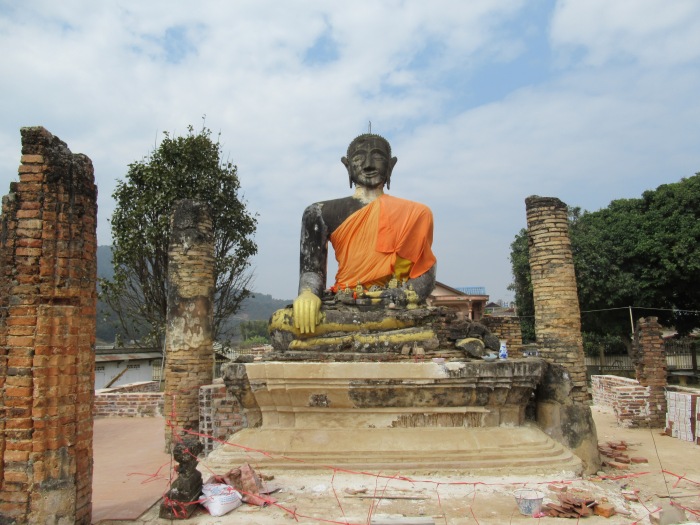In recent years the Lao province of Xieng Khouang has found itself the overland route for backpackers in South-East Asia. Travellers moving between the Lao and Vietnamese capitals might stopover in Xieng Khouang’s biggest city, Phonsavan, before getting a bus on to Vinh in the north of Vietnam. As novel as this route may seem, it is probably just the re-opening of an ancient trade route which linked the coast of Vietnam with the highlands of the Annamite Cordillera. One legacy of this ancient trade route may have been Xieng Phounag’s famous Plain of Jars. Another was the ancient royal capital of Muang Khoun.
Muang Khoun was once one of Laos’s richest settlements in terms of cultural heritage, with its wats such as Wat Phiawat and Wat Si Phum being renowned for the beauty of their old-world architecture. However, the province of Xieng Khouang was subject to saturation bombing from the United States in Laos, causing not only massive loss of human life but also the destruction of much of the country’s built cultural heritage. This loss was especially pronounced in the former royal city of Muang Khoun. In fact, not a single building was left untouched by the bombing and for many years, Muang Khoun was a ghost town. However, it is now coming back to life, with a few guesthouses and restaurants on the main street and many residents in the area. These signs of life notwithstanding, its wats are now either erased or in ruins.
Like most travellers, we decided to visit Muang Khoun from Phonsavan, which is the new capital of Xieng Khouang province. You can rent a Chinese motorbike from one of the businesses on the main street of town for 100,000 kip a day. The distance from Phonsavan to Muang Khoun is only thirty kilometres along a paved route, so it is an easy day-trip on a motorbike. However, we visited the area in early February and the weather was cold and cloudy. With the wind-chill factor added, we soon felt that it was too cold to continue without gloves and hats. So we started looking for these in the general stores which appeared intermittently along the roadside between the two towns, and found some gloves and beanies at the third shop we stopped at. While it was still cold even with gloves and beanies, we made it on to Muang Khoun with only one more stop along the way.
Muang Khoun is set in a valley in the highlands, with a river running along one side of the town and hills surrounding the town on all sides. The main street has a few local guesthouses, restaurants and shops; it is far from the desolate ruin which is sometimes described in the guidebooks. Within a few more years, it may even have backpacker-oriented guesthouses and cafes and be established as a destination in its own right. In the meantime, it is increasing in popularity with tourists on day trips from Phonsavan and we were to encounter a few on our tour of the town’s pre-war ruins. In fact, the first encounter happened a few minutes later at Wat Phiawat, the town’s best-known sight. There was an older English woman being shown around the wat by a local tour guide.
Like many tourist attractions in Laos, there is a 10,000 kip entrance to the wat, which was located by a group of ladies at the entrance gate. We quickly learned that the wat had been renovated, with some new wooden buildings having been built on the grounds and some monks in residence. However, none of these buildings are of any real distinction. The reason to come here is still because of the ruins of the former vihaan. It consists of the original brick foundation of the structure, which has emerged relatively unscathed from the war. On top of the base are the broken remains of a few brick columns, with many missing entirely. The timber roof which it once supported is now gone without a trace. Then at the end of the platform is a large seated Buddha which somehow survived the bomb largely intact.

This monumental, 14th century Buddha is seated on a lotus pedestal, which is made of bricks covered with a few extant patches of the original plaster. It is flanked on either side by the final two of the brick columns. The Buddha is seated in the bumisparshamudra, or the touching the earth posture, with his long, elegant fingers reaching down to the ground. Its legs are folded in the lotus position and its body has a solid, substantial look. There is considerable damage to the left knee area, which has been partly blasted away. The head is noteworthy for its elongated ear-lobes, with their suggestion of royal lineage, its clearly drawn features and its hair, which is rendered in a series of cylindrical spikes. Its hair is mostly intact though there is a large ‘bald’ patch at the back, where the spikes have been destroyed. Its right eye is also badly damaged, forming a sharp contrast with the relatively intact left eye. Finally, some weeds are growing from a missing portion of the Buddha’s forehead.

Overall, the Buddha makes a melancholy impression, as you admire its evident beauty but also reflect on the damage which has befallen it, and indeed the people of the province. It is actually very reminiscent of the ruins of Ayutthaya, a former Thai capital which was destroyed by Burmese cannons in 1767. There too you find temple bases, broken columns and time-worn Buddha statues exposed to the elements. It is also worth mentioning that at the time of our visit, the whole base was being covered in modern, terracotta tiles which are very unsympathetic to the historic nature of the ruin. Hopefully, funds will eventually be found for a more sensitive conservation of the town’s surviving monuments.